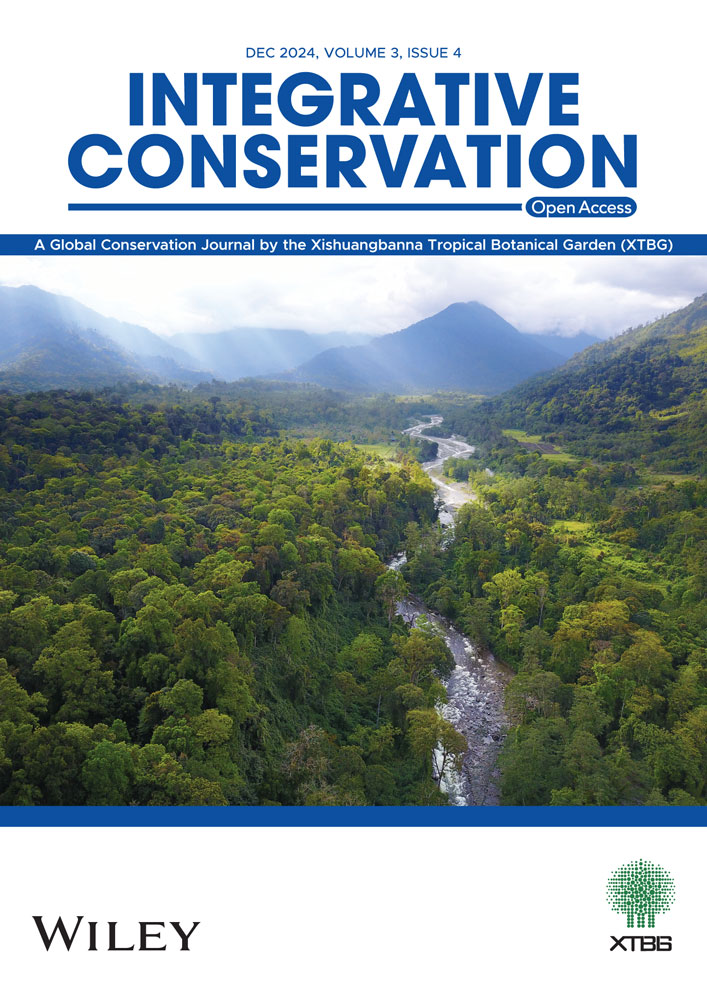Biosphere reserves in the megadiverse Cape Floristic Region are effective in conserving arthropod diversity
开普植物区的生物圈保护区有效保护了节肢动物多样性
Editor-in-Chief & Handling Editor: Ahimsa Campos-Arceiz
Abstract
enBiosphere reserves (BRs) aim to protect global biodiversity alongside social and economic development. Each BR is composed of a core area where biodiversity conservation is maximal. Surrounding this zone is a buffer and then a transition zone where agroecological farming and other low-intensity land-uses are undertaken to an increasing degree. The Cape Floristic Region (CFR) is a biodiversity hotspot at the southern tip of Africa, extremely rich in endemic plants and arthropods. We review the instigation of four CFR BRs for effective conservation to protect this unique biodiversity, and where new species are regularly being discovered. Core areas protect many endemic and rare arthropod species with impacts from human activities in these critical areas being softened by the outer zones. Within the buffer and transition zones, agroecological approaches are advancing arthropod conservation, largely through maintenance of natural patches in the agricultural matrix. While larger patches are better, small patches also have high value for arthropods, especially when functionally connected. Other biodiversity-friendly farming methods such as high vegetation cover between vine rows are also proving to be effective for indigenous arthropod conservation, as is an ecologically sensitive pest management strategy. Furthermore, a national programme aimed at removal of invasive alien trees is enabling arthropod recovery, especially endemic stream insects. Although fire is a natural CFR phenomenon, increased fire frequency is of concern. Nevertheless, natural fire refuges remain vitally important and are playing a critical role, especially for vulnerable species-rich groups like pollinators. Overall, there is optimism that most arthropod species will remain at effective population levels in this megadiversity hotspot by putting in place effective precautionary measures. Here we show that the BR model contributes towards the protection of the CFR's endemic arthropod fauna, with potential to expand the BRs beyond the four official reserves.
摘要
zh生物圈保护区(BR)旨在保护全球生物多样性的同时促进社会和经济发展。每个生物圈保护区都包括一个核心区域,该区域的生物多样性得到最大程度的保护。核心区的外围是缓冲区,再往外是过渡区,在这些区域,农业生态耕作和其他低强度土地利用的方式逐渐增多。开普植物区(CFR)是位于非洲南端的生物多样性热点地区,拥有极其丰富的特有植物和节肢动物。我们回顾了为有效保护这一独特的生物多样性而设立的四个开普植物区生物资源保护区,在这些地区经常有新物种被发现。开普植物区的核心区致力于保护众多特有和稀有的节肢动物物种,而外围区域则有效减缓了人类活动对这些关键区域的影响。在缓冲区和过渡区内,农业生态学方法正在推进节肢动物的保护工作,主要是通过维护农业基质中的自然斑块来实现。尽管较大的自然斑块更为理想,小型斑块对节肢动物同样具有很高的价值,特别是当它们在功能上相互连接时,其重要性尤为突出。其他对生物多样性友好的耕作方法,如葡萄树行间的高植被覆盖,以及对生态敏感的害虫管理策略,同样被证明能够有效保护本土节肢动物。此外,一项旨在清除外来入侵树木的国家计划也正在促进节肢动物的恢复,尤其是针对特有的溪流昆虫。虽然火灾是开普植物区的自然现象,但火灾频率的增加令人担忧。尽管如此,天然防火区仍然非常重要,并且正在发挥关键作用,特别是对传粉昆虫等物种丰富的脆弱群体而言。总体而言,人们对实施有效预防措施以保持这一生物多样性热点地区内大多数节肢动物物种的有效种群水平持积极乐观态度。在这里,我们阐述了生物圈保护区模式对于保护开普植物区的特有节肢动物群落的重要贡献,并有潜力将生物圈保护区扩展到四个官方保护区之外。【审阅 :姜楚】
Plain language summary
enBiosphere reserves (BRs) consist of various zones with different intensity levels of nature conservation across zones. Boundaries among BR zones are gradual and indistinct. The central core zone, comprised of nature reserve networks, is the area with highest biodiversity conservation priority, supporting full arthropod assemblages. Surrounding the core zone is the buffer zone, and wider, the transition zone, where low impact land uses are permitted, so providing suitable habitats to arthropod biodiversity alongside human activities. Here, we review progress being made towards arthropod conservation in four such BRs in the Cape Floristic Region (CFR) biodiversity hotspot of South Africa. Core areas protect many rare and endemic arthropods. In the buffer and transition zones, agroecological farming and appropriate management further improve regional conservation efforts. This is done through maintenance of natural patch quality and connectivity, encouraging vegetation cover among planted vine rows, removal of invasive alien trees, conservation and management of water resources, and working towards appropriate management of fire events, a natural phenomenon in the region. The BR model is effective for arthropod conservation in this megadiversity hotspot, and has good potential for expansion to other areas beyond the reserves reviewed here.
简明语言摘要
zh生物圈保护区(BRs)由不同自然保护强度的多个区域组成。生物圈保护区各区域之间的界限是渐进且模糊的。中央核心区由自然保护区网络组成,是生物多样性保护优先级最高的区域,支持着完整的节肢动物群落。核心区的周围是缓冲区,再往外是过渡区,在这些区域允许进行对环境影响较小的土地利用,从而在人类活动的同时为众多节肢动物提供合适的栖息地。在此,我们回顾了南非开普植物区(CFR)这一生物多样性热点地区的四个生物圈保护区在节肢动物保护方面取得的进展。开普植物区的核心区保护着许多稀有和特有节肢动物。在缓冲区和过渡区,农业生态耕作和适当的管理进一步增强了区域保护工作。具体做法是通过保持自然斑块的质量和连通性、鼓励在种植的葡萄树行间增加覆盖植被、清除外来入侵树木、保护和管理水资源,并致力于对火灾事件进行适当管理来开展该区域节肢动物多样性保护。生物圈保护区模式在这一生物多样性极为丰富的热点地区对节肢动物的保护是有效的,并且极有潜力扩展到本文所回顾的保护区以外的其他地区。
Practitioner points
en
-
The Cape Floristic Region (CFR) is an important biodiversity hotspot in southern Africa.
-
Biosphere reserves (BRs) protect biodiversity alongside social and economic development.
-
The BR model and agroecological advancement strongly support arthropod conservation.
-
The BR model can help reconcile human expansion with nature conservation.
实践者要点
zh
-
开普植物区(CFR)是南部非洲重要的生物多样性热点地区
-
生物圈保护区(BR)通过社会和经济发展保护生物多样性
-
生物圈保护区模式和农业生态进步为节肢动物保护提供了有力支持
-
生物圈保护区模式有助于协调人类扩张与自然保护之间的关系
1 INTRODUCTION
The Man and the Biosphere Programme (United Nations Educational, Scientific and Cultural Organisation) is an international initiative that promotes establishment of the biosphere reserve (BR) concept. BRs are required to fulfil the three functions of biodiversity conservation, sustainable development, and logistical support for these activities (Pool-Stanvliet et al., 2018). Globally, there are currently 738 BRs in 134 countries, with ten in South Africa and four within the Cape Floristic Region (CFR) at the southwestern tip of Africa: Cape Winelands BR, Kogelberg BR, Cape West Coast BR, and Garden Route BR (https://www.unesco.org/en/mab).
Africa as a whole poorly represents BR instigation with only 86 reserves on the continent, compared to the 261 BRs in Europe, and 58 BRs in Spain alone. This proportion indicates that the African continent, in view of its high levels of biodiversity, needs more consideration.
Each BR consists of three zones. The first is the central core zone where there is full biodiversity conservation, normally as set-aside land specifically for conservation and often designated a formal protected area. Surrounding the core is a buffer zone, which typically protects the core zone, with only low impact land use permitted, specifically agroecological farming, sustainable harvesting of natural resources and tourism, along with the natural areas. The outermost zone is the transition zone where there are more extensive human activities, although agroecological farming and sustainable practices are encouraged. Within the CFR's BRs, this zoning approach aims to integrate and harmonize agricultural production with biodiversity conservation. However, the zones in practice have indistinct edges and are largely put in place post hoc and relative to existing human activities and conservation practices. This means that while BRs are often conceptualized as three concentric polygons representing the three zones (Figure 1), in reality, the boundaries between zones are far more difficult to discern.
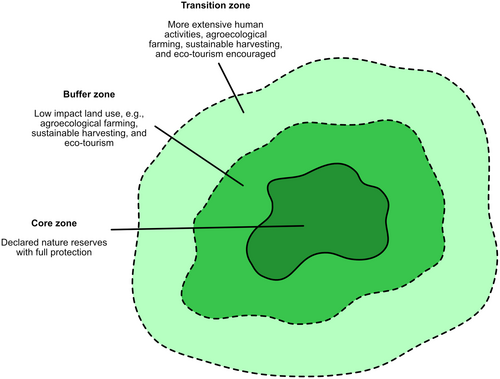
1.1 The Cape Floristic Region's exceptional biodiversity
The CFR is a Mediterranean-type region, and with an extent of about 90 000 km2, it is the smallest floristic region in the world (Figure 2). It is high in local plant endemism, and of the 9 000 or so plant species, 70% are endemic to the region (Goldblatt and Manning, 2002; Goldblatt, 1997). The CFR is also listed as one of the world's biodiversity hotspots, implying very high biodiversity levels while facing severe human impacts (Mittermeier et al., 2004). This region is composed of various vegetation types, but dominated by fynbos (sclerophyllous shrubland), renosterveld (grassy shrubland), strandveld (coastal shrubland), with pockets of Afrotemperate forest. As with all Mediterranean-type biomes globally, biodiversity is disproportionately sensitive to land-use and climate change (Newbold et al., 2020). However, the exact level of arthropod diversity is not known except for a few conspicuous groups, owing to the seemingly extremely high numbers of species, especially in less conspicuous groups. Furthermore, new species are being discovered on a regular basis, and following molecular analysis, many cryptic species complexes are coming to light (Samways et al., 2024).
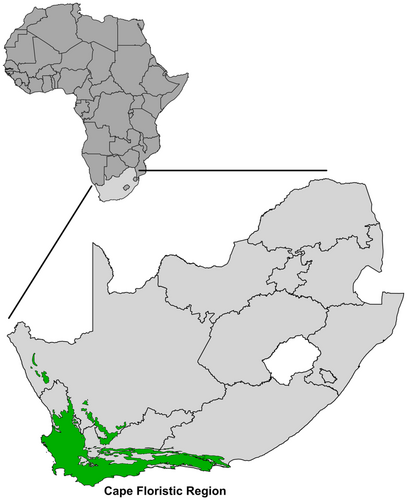
Threats in the CFR are mostly from landscape transformation, habitat loss and fragmentation, and invasion from alien plant species (Rouget et al., 2014). Nevertheless, considerable progress has been made in conserving arthropod biodiversity in BRs of the region. The core areas and buffer zones of the BRs are identified through negotiation between all stakeholders. Once the biosphere reserve is established, priorities can be re-assessed in an iterative manner while critically appraising what conservation action has been effective relative to existing and emerging threats (Heijnis et al., 1999). This approach also requires effective management decisions.
1.2 Aims and structure of the review
We summarise recent evidence on the effectiveness of the four current BRs in the CFR for conserving arthropods in this megadiverse region. We performed a literature search on the Web of Science online database, searching article titles, abstracts and keywords to identify articles for inclusions in this review (refer to Supplementary File 1 for the list of keywords used in the search). Research articles that did not focus on arthropods specifically, those that investigated marine arthropods, and those that were outside the geographic scope of the CFR, were excluded from this review. References within relevant articles, and several articles that were missed by the keyword search but gathered through additional expert searches, were also included.
We summarise the value of BR core areas and evaluate the conservation impact of agroecological approaches to enhance arthropod diversity in buffer and transition zones. We then summarize findings on other management approaches that enhance arthropod conservation across whole BR areas. While the Table Mountain National Park on the Cape Peninsula is not a proclaimed BR, it effectively interacts with the surrounding landscape as one. Against the background of BR design and management, we highlight the exceptional biodiversity of Table Mountain and surrounding areas. Finally, we provide management recommendations for future directions, highlighting the relevance of BRs in arthropod conservation.
2 CAPE FLORISTIC REGION BIOSPHERE RESERVES
2.1 Kogelberg Biosphere Reserve
The Kogelberg BR (KBR) is at the heart of the CFR and was South Africa's first biosphere reserve, designated in 1998 (Figure 3). This BR has core terrestrial areas in the formally protected Kogelberg and Groenlandberg Nature Reserves, mostly restricted to mountainous areas. This core zone has extraordinarily high levels of biodiversity and endemism (Johns and Johns, 2001). The nature reserves are bordered by a buffer zone that is mostly in a natural and near-natural state, whereas the transition zone consists of specialized conventional deciduous fruit production and commercial timber plantations.
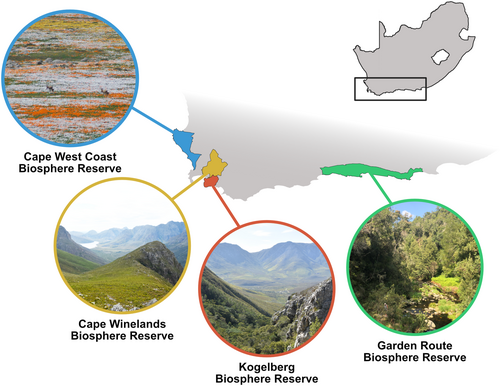
2.2 Cape West Coast Biosphere Reserve
The Cape West Coast Biosphere Reserve (CWCBR) is located on West Coast of South Africa, designated in 2000 (https://www.unesco.org/en/mab) (Figure 3). The core area of the BR is centred around West Coast National Park and is known for its mass flowering displays in spring and for protecting West Coast renosterveld, sand plain fynbos, and coastal strandveld vegetation types, all being unique to this region. Surrounding the BR core are game farms and some mixed agriculture. Agriculture dominates the landscape outside the protected area, with wheat and canola production along with cattle farming being most prominent.
2.3 Cape Winelands Biosphere Reserve
The Cape Winelands Biosphere Reserve (CWBR) is in the centre of the CFR wine growing region and was established in 2007 (Figure 3). The core area of this BR is in the Hottentots-Holland Nature Reserve which protects the mountains and the water catchments for much of the area. Surrounding the core and at lower elevations are conservancies and low impact viticulture. Much of the CWBR transition zone is highly productive wine farms and urban areas.
2.4 Garden Route Biosphere Reserve
Established in 2017, the Garden Route Biosphere Reserve (GBR) is on the eastern limit of the CFR, incorporating both fynbos and naturally patchy forest (Figure 3). Core areas include the Garden Route National Park, Tsitsikamma, Goukamma and Robberg Nature Reserves. Much of the surrounding area has been converted to plantation forestry and dairy pastures. In the buffer zone, sustainable timber harvesting is permitted.
3 VALUE OF PROTECTED AREAS AS CORE AREAS FOR BIOSPHERE RESERVES
The protected areas in the CFR are exemplary in their high levels of alpha, beta, and gamma diversity among many taxa. This emphasizes the conservation value of extensive protected areas, especially as habitat loss, fragmentation and degradation, and threats from invasive alien species are the dominant stressors across the CFR (Rouget et al., 2014). However, there is a bias towards protected areas in the upland areas, constraining representation of overall biodiversity patterns and processes. Although almost 50% of the Mountain Fynbos Complex is conserved, most habitat diversity is poorly represented in the current protected area system. Only 9% of the remaining primary major habitat units in the lowlands are currently conserved. Spatial components of the ecological processes identified in the CFR are poorly protected by the current conservation area network, although floral and faunal movement is possible in the uplands due to the strong spatial connectivity of the protected network (Rouget et al., 2003).
An example of the value of the core zone in the KBR is among dragonflies (Odonata). Of the 38 dragonfly species in the reserve, six are endemic to the CFR, another five are national endemics, and the rest a combination of regionally rare or common species (Grant and Samways, 2011). Four species are red listed as threatened, emphasizing that this BR is a stronghold and a micro-hotspot for supporting endemic and threatened species. Furthermore, and seemingly counterintuitively, the total abundance of the endemic and red-listed species is greater than that of the widespread habitat generalists. The core zone is by far the most important with 33 species, then the buffer zone with 20 species, and the transition zone with 14 species, but only 8% of species are exclusive to the buffer zone and 5% exclusive to the transition zone, none of which are endemic or threatened red-listed species, emphasizing the importance of the core zone (Grant and Samways, 2011).
4 AGROECOLOGICAL ADVANCES FOR IMPROVING CONSERVATION IN THE BUFFER AND TRANSITION ZONES
4.1 Edge effects between zones
Species turnover of surface-active arthropods in the KBR is related to mesoclimate, fire history, and geology. In this BR, the buffer zone has important complementary value and increases representativeness across the landscape, especially in areas of increased intra-annual temperature variability. As deciduous fruit orchards influence arthropod diversity in adjacent natural areas by <1 km, the buffer zone is important for protecting the core zone, for example, by reducing the impact of too frequent fires and any pesticide drift. Across all KBR zones, habitat quality in the form of high plant diversity, low human disturbance and being clear of alien invasive plants, is a key determinant of katydid diversity (Thompson et al., 2020). This highlights that good management of the buffer zone is essential for long-term maintenance of the arthropods in the core, as well as promoting biodiversity within the whole BR (van Schalkwyk et al., 2019).
At the smaller spatial scale of the edges between deciduous fruit orchards and natural habitat in the KBR, it is important that there are buffers of >85 m wide where management (such as fire protection, control of invasive alien plants, and avoidance of spillover of fertilizers) protects the natural habitat to sustain natural arthropod diversity (van Schalkwyk et al., 2020a). This approach is enhanced where there is improved functional connectivity at this smaller spatial scale within buffer and transition zones (van Schalkwyk et al., 2020b). As spillover from natural vegetation to orchards is not enhanced by reduced edge contrast or reduced crop management intensity, an important way in which this connectivity could be achieved is through corridors and stepping-stone habitats of natural vegetation (van Schalkwyk et al., 2020b), although this has yet to be tested in the region.
In the GBR, edge effects, as measured by arthropod compositional changes, were only 20 m between the fynbos and Afrotemperate forest, which is far smaller than when forests are adjacent to the structurally similar pine plantations (30 m), and clear felled areas (50 m) (Swart et al., 2018). Interestingly, hiking paths show edge effects into Afrotemperate forests of around 5 m, narrow 4 × 4 tracks about 20 m, and gravel roads >50 m, indicating how sensitive this vegetation type is to fragmentation (Swart et al., 2019).
4.2 Agroecological farming in the buffer and transition zones
With agricultural intensification threatening biodiversity, there has been a shift in the CFR to agroecological farming especially in vineyards of the CWBR. These approaches focus on reduced management intensity within crop fields and increasing heterogeneity throughout the farmland mosaic. This shift requires identifying locally specific management practices that are practical and can effectively enhance biodiversity, guiding farmland conservation efforts.
In CWBR vineyards, overall arthropod species richness, and that of predators, detritivores, and herbivores is highest in natural sites, followed by organic vineyards and then by integrated vineyards, partially due to higher non-crop vegetation complexity and less intense management in the organic vineyards (Gaigher and Samways, 2010). For species composition, arthropod assemblages are similar in organic and integrated vineyards, both of which are complementary to natural sites. Furthermore, variation among arthropod assemblages associated with natural vegetation is also much greater than among arthropod assemblages of cultivated sites. While organic vineyard management makes an important contribution to arthropod conservation in the CFR at the field scale, at the landscape scale, natural habitat supports a much more diverse set of species. This emphasizes the importance of conserving natural fragments in the vineyard landscape as an effective measure to maintain biodiversity of production landscapes in the CFR (Gaigher and Samways, 2010).
While ground-living spiders are diverse in vineyards of the CWBR, especially in organic vineyards, it is natural habitat remnants that contribute significantly to overall spider diversity (Theron et al., 2020). Natural vegetation remnants support rare and range restricted species, and many species absent from the agricultural matrix. Both patch- and landscape-scale variables influence spider diversity and assemblage structure. Remnant patch size and its vegetation, as well as topographic variety, positively influence overall spider diversity and assemblage structure of all guilds. Spider diversity is maintained by remnants of good quality natural vegetation, but also influenced by the complexity of the landscape. Conservation of remnant vegetation patches, regardless of size, across privately-owned farm conservancies maintains spider diversity, an encouraging sign (Theron et al., 2020). Other environmental variables relating to plant diversity, management intensity, and distance to nearest natural habitat influence spider abundance and species richness in vineyards (Gaigher and Samways, 2014).
Vineyard management practices in the CWBR are being improved, but advances require verification. In a study of arthropod biodiversity in vineyards under varied management intensities, the most influential factor is percentage herbaceous vegetation cover in vineyards, which has a positive effect on arthropod species richness across several taxa (spiders, beetles and true bugs), microhabitats (ground level, on cover crops, and on vine foliage), and feeding guilds (herbivores, omnivores and predators) (Geldenhuys et al., 2021). Other vegetation-related variables, such as volume of plant litter, plant species richness, and plant height also positively influence the biodiversity assemblages present. This multi-taxon approach did not find any negative effect of agrochemicals used in an integrated approach, or any strong effect of overall farming approach (organic vs. integrated) on the species richness or evenness of any of the focal taxa, sampled positions, or guilds. But in this area, vineyards are under the auspices of the Integrated Production of Wine Programme, which applies pesticides with much discretion. Overall, indications are that the maintenance of dense and diverse cover crops, along with sensitive management supports integration of biodiversity conservation with farming. It also highlights that minimal adjustment to management practices can greatly benefit farmland biodiversity conservation and is in keeping with the ethos of the BR concept (Geldenhuys et al., 2021).
In vineyards, herbaceous vegetation cover promotes ubiquitous arthropod species richness, although neither vegetation cover, nor any other in-vineyard measures promote spillover from fynbos into vineyards (Geldenhuys et al., 2022a). However, assemblages on the soil surface display lower nestedness differences, indicating greater spillover by these ground-level arthropods. This emphasizes again the importance of conserving natural fynbos patches alongside sensitively managed vineyards for harmonizing biodiversity conservation and viticulture (Geldenhuys et al., 2022a).
Furthermore, these assemblages in integrated vineyards are similar in composition irrespective of landscape context, whereas they are different among organic vineyards in landscapes with different levels of natural vegetation. This indicates a relatively lower homogenizing effect of organic farming compared to nonorganic farming on landscape-scale biodiversity. The point here is that within this farming and conservation mosaic, it is important to consider the interplay between local management and the surrounding landscape in promoting biodiversity (Geldenhuys et al., 2022b) (Figure 4). Further assessment of how on-farm measures can promote species turnover across the buffer and transition zones will be important to prevent regional homogenization in the BRs.
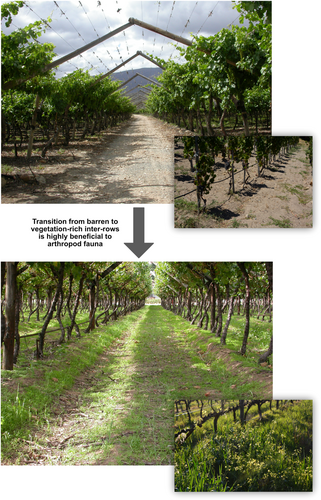
Vineyards support a relatively high taxonomic diversity of arthropods, and high species turnover, although compositionally, assemblages differ greatly from those in nearby natural habitats in the CWBR. Vineyards also support lower functional diversity of spiders and beetles (Geldenhuys et al., 2022c). Assemblage composition among the two taxa differs according to system relative to arthropod traits. Plant-dwelling spiders and small-bodied beetles are strongly positively associated with fynbos, and predatory beetles within vineyards. Common spiders and predatory beetles are strongly negatively associated with fynbos. Overall, results indicate that well-manged vineyards can support high arthropod diversity (Geldenhuys et al., 2022c), while also recognizing that inter-rows with high plant species diversity can improve food networks in the case of web-building spiders (Arvidsson et al., 2020). However, remnant patches conserve irreplaceable biodiversity and functional diversity, making their continued conservation in farmland a priority (Figure 5).
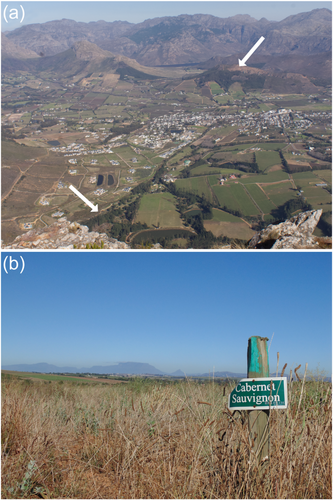
A further consideration is soil compaction which is higher in agricultural areas than in natural vegetation in the CFR. While degree of soil compaction negatively correlates with arthropod species richness but not with abundance, neither soil moisture nor leaf litter depth on their own significantly affect arthropod species richness or abundance. Furthermore, alien trees have a strong negative effect on both arthropod species richness and abundance, and much more so than vineyards. However, the situation is reversible, with removal of the alien trees leading to a rapid recovery of soil structure and of arthropod assemblages (Magoba et al., 2015).
Grasshopper abundance is highest in CWBR vineyards compared to either fynbos or deciduous fruit orchards. However, species richness, diversity, and evenness are highest in fynbos, followed by vineyards then orchards. In turn, orchards have no unique species, while vineyards have few unique species, and assemblages are overall similar between vineyards and orchards. Fynbos has several unique species, mostly made up of flightless endemics, with open vineyards offering more opportunities than canopied orchards. Maintaining patches of natural good quality fynbos among transformed land is essential for securing endemic species (Adu-Acheampong et al., 2016).
As fynbos transformation progresses, there is replacement of endemic grasshopper species with more widespread generalist species (Adu-Acheampong and Samways, 2019a). Besides land-use type and species traits, seasonality also plays a major role in their spatial dispersion patterns. Highly mobile, generalist feeders are abundant and widely dispersed across the landscape, especially late season when they can take advantage of high plant productivity in the vineyards. In contrast, low mobility, specialist feeders only occupy natural fynbos vegetation in both seasons. Furthermore, highly mobile generalists benefit in two ways: being able to occupy transformed areas, while receiving a population boost late season. In the case of low-mobility specialists, they are doubly disadvantaged: not able to move far, while lacking their specific host plants in the transformed areas. This means that the conservation emphasis for CFR endemic grasshoppers needs to be on improving functional connectivity in natural fynbos (Adu-Acheampong and Samways, 2019b). Among species in the CFR endemic grasshopper genus Euloryma, two species, E. umoja and E. ottei can tolerate some transformation away from fully natural fynbos. However, the traits of E. larsenorum and E. lapollai are such that they can only survive in fully natural fynbos (Adu-Acheampong et al., 2017).
In turn, there are only weak differences between grasshopper assemblages in the riparian zone of CFR rivers compared to the terrestrial zone, apparently driven by deep history, complex geomorphology, stressful environmental conditions, a diverse vegetation, land mosaics, and possibly high predator pressure. The large-sized, well-flighted, geographically widespread generalists are more abundant in the riparian than terrestrial zone, while the small, flightless or poorly flighted vegetation specialists that are narrow-range endemics are adapted to both riparian and terrestrial zones but are most abundant in the terrestrial zone. Overall, indications are that narrow-range CFR grasshoppers are best conserved in the terrestrial zone (Pronk et al., 2017).
In the case of parasitoids, fynbos fragments are higher in abundance, species richness, and diversity than vineyards, with little spillover between the two systems, and very different assemblages in both. While the remnant fynbos patches are isolated, they are important reservoirs of natural parasitoid diversity. Improvements to the agricultural matrix through encouraging functional connectivity would likely enhance long-term persistence of parasitoids, especially during adverse weather events (Gaigher et al., 2015).
Abandoned vineyards represent an intermediate level of transformation between natural vegetation and productive vineyards. They are closest to natural vegetation in their parasitoid and predator arthropod diversity, while also having some unique species in these two guilds, with overall parasitoid and predator diversity benefiting from high plant diversity and arthropod prey abundance in the abandoned vineyards. Parasitoids have greater habitat specificity than the predators, with the parasitoids likely to benefit most from an improved mosaic of natural vegetation and abandoned fields plus better functional connectivity (Gaigher et al., 2016) (Figure 5).
5 POLLINATOR DIVERSITY AND AGROECOLOGICAL ADVANCES IN THE BUFFER AND TRANSITION ZONES
Bees and monkey beetles are important pollinator guilds in the CFR. When organic versus conventional farming are compared within CWBR vineyards, species richness of monkey beetles (Scarabaeidae: Hopliini) but not that of bees benefits from organic farming, indicating that landscape context and management is taxon specific. Furthermore, monkey beetles, being specialised pollinators, are strong indicators of human disturbance (Kehinde and Samways, 2012). However, when vineyards are adjacent to natural fynbos, they do not show significant homogenization of pollination interaction networks or of the flower-visitor community when compared to natural sites. This means that organic viticulture can be integrated with vineyard management through a set-aside process, so harmonizing biodiversity conservation with agricultural production (Kehinde and Samways, 2014a). Importantly however, remnants must have high abundance of flowering plants. Local diversity and spatial turnover of flowering plant diversity are significantly higher in fynbos compared to both organic and conventional vineyards, and congruent with bee diversity (Kehinde and Samways, 2014b).
Organic vineyards are characterized in part by inter-rows of vegetation between the vine rows. When these inter-rows are diverse in flowering plants, they attract a wider variety of wild bees (Kratschmer et al., 2021). Planting of indigenous plants within apple orchards enhances pollinator activity within the orchards and improves apple quality, so reducing reliance on rented honeybee (Apis mellifera capensis) hives. The practice of enhanced planting indirectly contributes to improved landscape-scale resilience and connectivity while also benefiting pollinators within the remaining natural habitat (Ratto et al., 2021). Future similar work that highlights both economic and ecological benefits of agroecological approaches would benefit its adoption in the BR context.
Overall, these findings emphasize that biodiversity-friendly management practices ensure species-rich plant communities that support high pollinator diversity. Importantly, it is necessary to maintain mosaics of natural and semi-natural habitats in agricultural landscapes to conserve both plants and bees (Kehinde and Samways, 2014c). Furthermore, fragment size and distance to large remnants of vegetation has a significant influence on seed or fruit set in certain plant species, emphasizing that pollination interactions must be viewed from both the plant and pollinator perspective (Donaldson et al., 2002). Even small fragments of natural vegetation can support a diverse pollinator assemblage, indicating that these small areas can represent at least some of the heterogeneity of the CFR, and can act as important stepping-stone habitats (Hauber et al., 2022) (Figure 6).
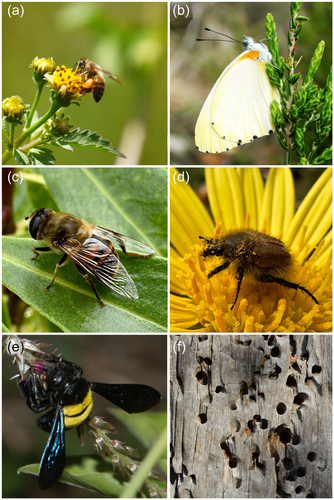
6 CFR BIOSPHERE RESERVE MANAGEMENT FOR ARTHROPOD CONSERVATION
6.1 Managing for fire events
CFR vegetation is fire-prone and fire-adapted, with fire being a principal driving force in the ecological dynamics of fynbos and renosterveld ecosystems, and both inevitable and necessary. However, with an increasing human population, fire events have become more frequent than in the past (Van Wilgen, 2013). For arthropod conservation, better understanding of historically complex fire survival by various taxa and guilds is needed.
Some groups, such as ants, are highly resilient to fire, while others, like pollinators, are less resilient at a local scale. As fire also allows new species to enter burned sites, it can promote local biodiversity, so long as fire events are not too frequent (Pryke and Samways, 2012a). This differential resilience to fire events emphasizes the importance of sampling a wide range of groups to represent overall responses of compositional biodiversity. This means using a variety of groups, such as butterflies, ants, and scarab beetles, for monitoring arthropod recovery following fire, while also having adequate control sites, as there is much annual variation in arthropod diversity and abundance in unburned areas (Pryke and Samways, 2012b).
Furthermore, the effect of fire on species diversity and abundance varies greatly among taxa. This effect emphasizes the importance of using species compositional diversity measures, especially as different time-since-fire categories support distinctive assemblages, and that some indicator species are present across all temporal categories while others are present only at one time-since-fire category (Yekwayo et al., 2018).
Even within guilds there can be different responses to fire. In the case of spiders, while there are no differences among web-builders relative to time since fire, wandering spiders take longer to recover than web builders. In practical terms, this means that wanderers are good candidates for monitoring postfire recovery (Yekwayo et al., 2019).
Species composition of flowering plants and anthophiles, especially bees and flies, differ significantly across postfire categories. Flower and bee abundance are largely congruent. For the other anthophiles, other resources such as logs for breeding flies are essential (Adedoja et al., 2019a). Importantly for conservation is that fire refuges, in the form of ravines, rocky outcrops, screes, and areas that by chance escape the fire front, play a major role in providing source areas from which to recolonize previously burned and recovering areas (Adedoja et al., 2019b). It is important that these refuges are present across the various zones of BRs, so mitigating the regional impacts of landscape transformation (Figure 7).
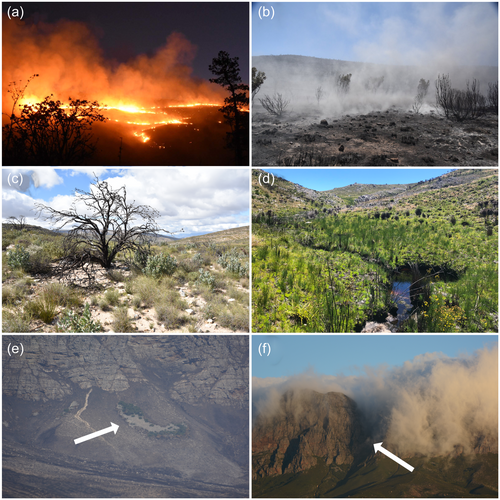
As there is high beta diversity of plants and arthropods in the CFR, fire management, especially in BRs, must be carried out carefully. This is emphasized by the insect borers on shrubby plants in the region (e.g., Protea spp.). There are distinct differences in frequency of occurrence of insect taxa associated with the various plant species as a result of physical host-plant characteristics, such as infructescence and seed set variables, and also there are local climatic factors. As plant diversity is largely maintained by burning, management burns should not be applied too frequently or over too large areas where there might be extirpation of borer species. As the borers are effective umbrella species for many other insect species, their conservation has applicability to CFR insect diversity in general (Wright and Samways, 1999).
6.2 Managing invasive alien species
Invasive alien plants, especially trees and shrubs, are highly impactful on CFR biodiversity and can aggravate fire events (Van Wilgen et al., 2016) (Figure 8). In terrestrial areas, alien trees in the genus Pinus are also interactive with the alien ant Linepithema humile by variously impacting indigenous ant species. Of particular concern is that formicine ants in the genus Camponotus are affected most, with these ants playing an important role in the burial of seeds of many indigenous fynbos plants, while also having obligate interactions with localized and endemic butterfly species (Schoeman and Samways, 2011, 2013). In the case of the small forest specialist butterfly Charaxes xiphares occidentalis, alien trees (Acacia mearnsii) are adversely synergistic with agriculturally induced landscape fragmentation, affecting its behaviour and ecology, and hence its survival (Crous et al., 2015).
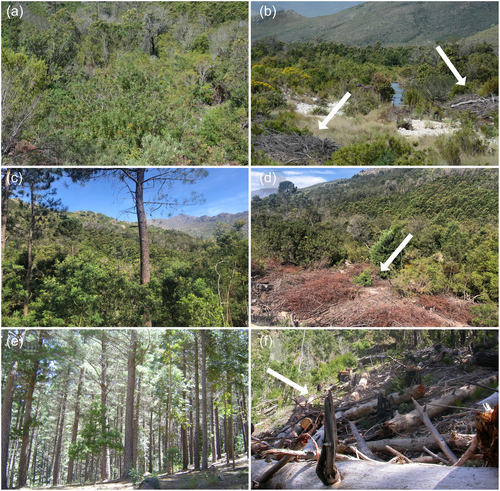
Comparison of surface-active arthropod species in vineyards of the CWBR, alien tree-invaded areas, and other areas cleared of the alien plants, indicate that species richness in cleared areas is higher than in vineyards and more similar to that in natural fynbos, while alien trees have lowest species richness (Magoba and Samways, 2012). Overall abundance is highest in cleared areas, closely followed by fynbos, then vineyards, and lowest under alien trees. Several species are restricted to each vegetation type, including alien tree infested areas. However, assemblage composition differs greatly among the vegetation types, with fynbos and vineyards grouping together. When rare species are excluded, vineyards and cleared sites group together, indicating some recovery but only involving those species that are abundant and habitat tolerant. In general, vineyards retain a greater complement of indigenous species than alien tree infested areas, but clearing of these aliens soon encourages establishment of indigenous species, with soil moisture and litter depth a major driver (Magoba and Samways, 2012).
There is a reduction in percentage light reaching the understorey of alien pine stands which reduces understory flower abundance, with no flowers under mature pine trees. When anthophile species diversity and interactions are measured at various distances in natural fynbos away from alien pine stands, anthophile species composition differs across sampling locations with increasing distance from the mature pine understorey, an indication of fynbos plant heterogeneity (Adedoja et al., 2021). Although pine trees cause a decline in flower-visitor interaction frequency and network specialization, some bee species that are mostly tree nesters, are present in unique interactions associated with mature pines and where the alien trees provide nesting sites. While alien pine tree removal is encouraged, especially where the trees are actively invading, maintaining well-contained small stands used for threatened mammal conservation, is of value for the indigenous anthophile taxa (Adedoja et al., 2021).
Among the invasive alien insects is Polistes dominula, which has now become one of the dominant wasp species at some localities surrounding the CWBR, displacing native P. marginalis (Benadé et al., 2014). While both species prefer human infrastructure for nesting, P. dominula is significantly more abundant than P. marginalis, despite the alien species having a higher parasitoid load. However, P. dominula has a much longer activity period and higher colony productivity than P. marginalis, meaning that it can reach much greater population size than P. marginalis despite the higher parasitoid pressure (Roets et al., 2019).
The invasive alien ant Linepithema humile can be adversely synergistic with landscape transformation. When apple orchards with intensive insecticide or acaricide programmes are compared with natural fynbos, far more species of Hemiptera, Hymenoptera, and Orthoptera are present in natural vegetation than in either orchard management type. Cydnid, rove, and ground beetle families are as species rich in the sprayed as in the unsprayed orchards, whereas Diplopoda and Isopoda are more abundant in the unsprayed than sprayed orchards. However, alien L. humile is the most abundant species in both orchard types. Overall, landscape transformation and intense use of pesticides has a negative impact on arthropod diversity in the KBR (Witt and Samways, 2004).
Among invasive alien fish, Rainbow trout (Oncorhynchus mykiss) can penetrate the headwater streams where much CFR biodiversity is present. Trout change community structure, as well as the dynamics of the algae-invertebrate interaction (Shelton et al., 2015), even though they feed mainly on terrestrial invertebrates, mostly insects, which fall on the water surface (Shelton et al., 2016). More information on other alien fish, for example, Largemouth bass and Smallmouth bass, is required, as these invaders may also have impacts on aquatic arthropods and low-flying insects.
The curculionid polyphagous shot hole borer (PSHB, Euwallacea fornicatus) is an ambrosia beetle, indigenous to southeastern Asia, now a global pest and first recorded in South Africa in 2017. The PSHB vectors various fungi species, including the pathogenic Fusarium euwallaceae which grows in the xylem and along gallery walls, providing nutrition for developing beetle larvae and adults. This activity blocks the xylem, leading to twig dieback and even death of the tree. There are to date 83 known tree host species (41 indigenous and 42 alien) in which PSHB can reproduce (FABI, 2023), some of which include economically important fruit trees. Uncontrolled, the beetle has severe ecological and economic implications for the CFR and other regions of the country (Van Rooyen et al., 2021). Current control methods include removal of infected material by pruning or felling of highly infested trees. These approaches are followed by wood chipping and sun exposure of the woody material, all of which are expensive and not feasible on a large scale. As chemical control (Roberts et al., 2024) and application of commercially available broad-spectrum entomopathogenic fungi (Bacillus thuringiensis; Beauveria bassiana) (Nel et al., 2023) against PSHB are only partially effective, successful beetle management will likely depend on a combination of chemical control and other control strategies in an integrated pest management programme. This approach would need to be coupled with a strict monitoring protocol where citizen science can play a major role (Potgieter et al., 2024). Of concern in the CFR, is that this invasive beetle has been confirmed from the KBR, CWBR, and GBR. Infestation in the GBR is particularly concerning, as a high number of indigenous Afrotemperate forest trees are highly susceptible to the pest and its mutualistic fungus (Townsend et al., 2024), which could have major conservation implications for arthropod conservation in the CFR. This emphasizes the urgency of developing an effective monitoring and control programme.
6.3 Reducing the impact of stressors on aquatic systems in the biosphere reserves
Alien invasive tree species (e.g., Acacia spp.) are a major threat to the freshwater systems, especially rivers across the CFR. However, there has been a largely successful major national initiative, the Working for Water programme, aimed at alien riparian tree removal across most rivers in the CFR (Van Wilgen et al., 2012).
Besides depriving indigenous plants of water, the alien trees have a huge impact on the local freshwater assemblages by shading out of understorey plants and through having a direct shading effect on the largely heliophilic arthropods (Remsburg et al., 2008). However, removal of the alien trees has enabled freshwater assemblages and communities to recover. For instance, the recovery process has seen the return of many dragonfly species (Samways and Sharratt, 2010) and macroinvertebrates (Samways et al., 2011), including several CFR endemic species.
The level of recovery has been quantified using dragonflies alone (Simaika and Samways, 2009), which can also stand in for other assemblages, such as the Ephemeroptera/Plecoptera/Trichoptera, the well-known and sensitive ‘EPT’ group (Kietzka et al., 2019). Furthermore, the Endangered damselfly Spesbona angusta has umbrella value for two further threatened odonate species, Endangered Proischnura polychromatica and Vulnerable Syncordulia legator, as well as some other CFR endemic odonates. Conservation of this species requires continual monitoring and removal of known invasive alien trees as a priority (Deacon and Samways, 2017). Monitoring and removal of new invading alien trees, such as Prosopis spp. already present in the northern provinces of South Africa, should also be prioritised to better protect other odonate assemblages.
Agricultural and urban landscape transformation both have a similar homogenizing effect on CFR dragonflies, with opportunities for local endemic species reduced while opening up opportunities for the widespread generalist species. Besides improved water and riparian conditions befitting the endemics, the presence of core BR zones is critical for them (Kietzka et al., 2018).
A challenge for aquatic insects in the CFR has been survival during severe droughts. Dragonflies, aquatic beetles, and aquatic bugs today have the alternative option of being able to retreat to artificial water bodies in times of severe drought, especially when these artificial ponds are similar in all abiotic and biotic factors to natural ponds (Deacon et al., 2019). While good quality natural ponds in the core zones of BRs are important, adequately managed artificial ponds, including those in buffer and transition zones, can make a substantial contribution to regional aquatic insect conservation (Figure 9).
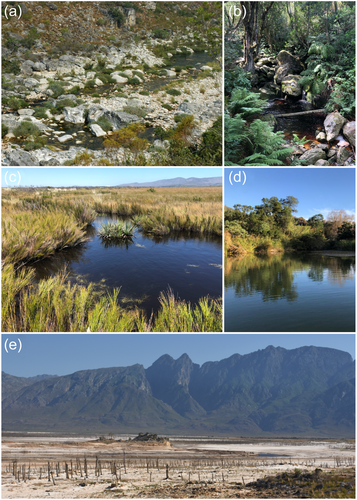
Among beetles and bugs, the proportion of CFR endemic species in high quality artificial ponds is 36% (Apinda Legnouo et al., 2014). Encouragingly, for sandy lowland fynbos wetlands, dense urbanization has not yet had any significant impact on aquatic macroinvertebrate species composition (Blanckenberg et al., 2020). The key to the success of artificial ponds for maintaining high aquatic insect diversity is a pondscape with a range of ponds with various degrees of water level fluctuation, along with naturally diverse marginal vegetation in this drought-prone region (Jooste et al., 2020).
6.4 Impact of river impoundment in the Cape Winelands Biosphere Reserve
As water is a relatively scarce commodity in the CFR, impoundments have been put in place to secure water supply for humans. However, impoundment of a small river in the CWBR core zone resulted in macroinvertebrate species diversity below the dam dropping to only half of that in the natural area catchment area above the dam. Furthermore, Ephemeroptera, Plecoptera and Trichoptera diversity and abundance dropped to almost zero because of changing physicochemical conditions brought about by the impoundment. In contrast, abundance of Chironomidae fly larvae increased substantially below the dam (Bredenhand and Samways, 2009).
The effects of river impoundment in the other BRs are likely similar, yet more investigation is needed to determine how local freshwater arthropod assemblages respond. Importantly, ways to reconcile the needs for water storage and conservation is needed. A step forward is to simulate natural riparian vegetation composition in transformed stream areas, reduce accumulation of pollutants, and allow dam water levels to fluctuate, as would be the case under natural riverine conditions.
7 THE ICONIC CAPE PENINSULA AND TABLE MOUNTAIN
The Cape Peninsula in the southwest of the CFR is renowned for its plant diversity but with many species threatened, even in the Table Mountain National Park (Cowell et al., 2023) (Figure 10). This region is not a BR, but is effectively designed as one, with the core area in the Table Mountain National Park with a string of mountains running along the peninsula but is surrounded by winelands and the city of Cape Town.
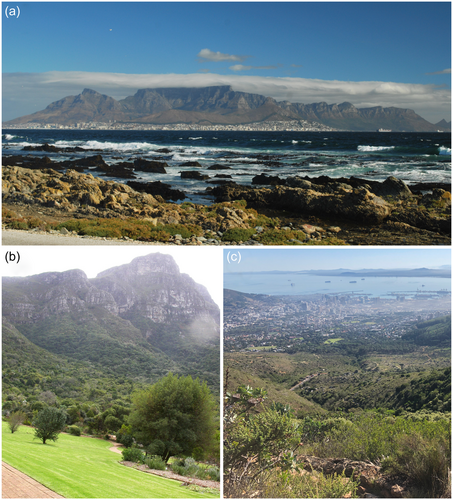
The area is also rich in invertebrate species, with many endemic species (Picker and Samways, 1996). This is due to a combination of historically favourable climate, isolation effects, and a complex topography. Elevation, slope, aspect, distance to water, and vegetation structure are the most important environmental variables for insects, with Table Mountain having most Red Listed species, while Cape Point has many unique species, and Noordhoek Wetland is important for aquatic Coleoptera. Small hills on the Peninsula are important for overall insect diversity. The high number of new Peninsula records, even for well-known taxonomic groups, indicates that still little is known of the insect assemblages across the Peninsula. For example, for spiders, Table Mountain National Park is the best-surveyed protected area in the CFR, supporting 11.4% of all South African spider species. Yet, further monitoring is needed to improve our knowledge of their distribution and management needs (Haddad and Dippenaar-Schoeman, 2024). Nevertheless, priority conservation areas include Table Mountain (for Red Listed species), Noordhoek (for aquatic Coleoptera) and Cape Point and the small hills across the Peninsula (for their unique invertebrate assemblages). Conservation of a variety of elevations is needed, including steep and flat areas, all aspects of mountains, as well as both the wet and dry areas, all contributing to the conservation of the Peninsula insects (Pryke and Samways, 2009a). An additional consideration is that as the surface-active and foliage arthropods have different local distributions, meaning that arthropod conservation depends on conserving many different habitats (Pryke and Samways, 2008).
Invasive alien plants, especially Pinus spp. trees, can have a major impact on indigenous arthropods. However, when removed as part of a restoration initiative, the arthropod assemblage showed remarkable differential resilience, reminiscent of recovery from fire. This was especially the case for fynbos arthropods, although for ravine forest species, recovery was slower. Of note is that the large Kirstenbosch Botanical Garden is an important refuge for indigenous species (Pryke and Samways, 2009b). While fynbos has high arthropod species beta diversity, the ravine forests have many habitat-specialist and highly localized endemic species. Table Mountain has a complex topography, and avoiding species loss requires total area protection. While the upper slopes and summit are well protected, the lower slopes require ongoing attention (Pryke and Samways, 2010).
The lowland aquatic systems are under pressure from two major stressors: high nutrient loads from the surrounding land, and transformation of the wetlands from seasonal to perennial water bodies or infilling to make space available for economic developments. Conservation recommendations include limiting urban waste from entering these systems, and management of water levels to simulate historical seasonal patterns (Deacon, Fox, Morland, et al., 2021). As aquatic arthropods on Table Mountain have such local distributions, it is essential to conserve both the aquatic systems and their supporting terrestrial matrix through careful selection of new sites for urban development (Deacon and Samways, 2021). Furthermore, removal of alien pine trees on Table Mountain enabled the recovery of nearly all dragonfly species, including CFR endemics. The only endemic that has not been re-recorded to date is the highly localized Orthetrum rubens, which appears not to be able to disperse from the nearby mountain ranges possibly because of the intervening inhospitable hot, dry plain and intense urbanization (Samways and Deacon, 2022).
The ancient caves on Table Mountain are phreatic in origin in hard quartzitic sandstone and support several troglobitic endemics including the threatened onychophoran Peripatopsis alba (Vulnerable) and the crustacean Spelaeogriphus lepidops (Sharratt et al., 2000). More recently, the number of cave-restricted arthropod species has been increased to 18, making it a hotspot of cave biodiversity (Ferreira et al., 2020), notwithstanding that the huge labyrinth of small cave extensions and crevices, impenetrable to human explorers, might well hold more endemic species. Currently the greatest risk is the increase in visitors and careless behaviour, especially the discarding of items in the caves. As the caves have narrow entrances, appropriate gating that does not restrict bat movement is a conservation option, and implementation of educational and promotional programmes can support conservation efforts.
8 DISCUSSION AND MANAGEMENT RECOMMENDATIONS
-
Protection of key habitats across elevation gradients. While mountainous areas are well covered by core zone protected areas, the lowlands are under much more pressure from agricultural and urban development. This means that in the lowlands, much effort is required to integrate arthropod conservation and human activities. Biosphere reserves are playing an important role here, as they incentivize farmers to convert to low impact farming.
-
Conservation of remnant natural patches in utilised landscapes. At the landscape scale, remnant patches of indigenous vegetation are important reservoirs for protection of many arthropod species. While large patches are best, small patches are not without merit, so long as there are not too many intense spillover effects from the agricultural matrix. However, not all endemics are conserved in these set-aside areas, as many species, especially small ones with specialized traits, require fully natural vegetation. For some species, these are areas for residence, but for others they are stepping-stone habitats. This emphasizes the importance of functional connectivity among patches across whole landscapes.
-
Conservation of diverse plant assemblages and structure at various spatial scales. Terrestrial arthropod conservation is highly dependent on a healthy indigenous plant base. There is strong indication that arthropod conservation effectiveness depends on plant macro- and micro-distribution, and many foliar and pollinator arthropods overall also depend on greater large- and small-scale vegetation heterogeneity.
-
Moving from conventional to agroecological farming approaches. Within agriculture-dominated landscapes, vegetated inter-rows play a role in supporting diverse species assemblages, including important pollinators and predators. Vegetated inter-rows can be of high value to habitat liberal and some endemic species, and these vegetation-rich areas among planted rows can aid connectivity and provide refugia in agricultural areas. The shift to agroecology is making vineyards more biodiversity-friendly through establishment of greater areas of suitable habitat for biodiversity. Together with applying a much more judicious approach to the use of pesticides, these two factors together are having a hugely positive effect for sustaining arthropod diversity.
-
Appropriate fire management. While fire events are a natural ecosystem driver in the CFR, they are becoming more frequent, meaning that fire management is a critical factor, both for plants and arthropods. Importantly, fire refuges play a critical role in maintenance of arthropod populations and should remain present throughout the various zones of BRs.
-
Management of invasive alien plants. There are many species of alien plants in the CFR, and it is the highly invasive ones that are the greatest problem. However, their timely removal has shown that much of the indigenous arthropod diversity, both terrestrial and aquatic, can return once invasive species are removed.
-
Conservation approaches mindful of aquatic environments. Aquatic arthropod diversity is highest in streams, seeps, and marshland in the largely upland areas. However, lowland aquatic biodiversity, especially those occupying riverine environments, are at great risk from invasive alien trees. In recent years, much attention has been given to alien tree removal, leading to substantial extinction reprieve for many aquatic and amphibiotic species. River damming and alien fish overall constitute a far lesser issue but should remain as management considerations.
The Cape Peninsula is well suited to be included as a BR in future, as it has a core area surrounded by an area of human disturbance. This is indicative that demarcation of more BRs in the CFR should be explored. To date, the effect of human modified landscapes, as well as the effects of climate change and extreme weather events on CFR arthropods, have been poorly explored. However, as much of the arthropod fauna is either of ancient origin or has shifted in response to climate change in the distant past, possibly there is some optimism for their survival in the shorter term, so long as eco-friendly agricultural practices and green urbanization help them along. Biosphere reserves seem well suited to help protect this unique faunal diversity.
AUTHOR CONTRIBUTIONS
Michael J Samways: Conceptualization; Funding acquisition; Investigation; Visualization; Writing—original draft; Writing—review and editing. James S Pryke: Conceptualization; Funding acquisition; Investigation; Visualization; Writing—original draft; Writing—review and editing. René Gaigher: Conceptualization; Funding acquisition; Investigation; Visualization; Writing—original draft; Writing—review and editing. Charl Deacon: Conceptualization; Funding acquisition; Investigation; Visualization; Writing—original draft; Writing—review and editing.
ACKNOWLEDGEMENTS
We thank the National Research Foundation, Stellenbosch University, and Mondi Group for funding this work. All photos are by the authors.
CONFLICT OF INTEREST STATEMENT
The authors declare that they have no known competing financial interests or personal relationships that could have appeared to influence the work reported in this paper.
Open Research
DATA AVAILABILITY STATEMENT
No original data were collected or analyzed for this review manuscript.



